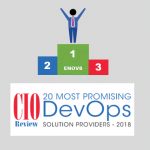Rise of the TEM Tools (DevOps Winners 2018)
After years in obscurity it appears that IT & Test Environment Management tools are now starting to get noticed.
This year saw several IT Environment Management products being nominated by CIOReview as the most promising DevOps tools. Most probably in recognition of the importance of managing your IT Environment & Operations to achieve "DevOps at Scale" and ultimately better manage you cloud landscape.
Congratulations to the winners Enov8 and the other CIO Review Top 20.
--- News Source ---
Enov8, the Enterprise IT Intelligence company, has been named winner of this year’s, 2018, CIOReview “20 Most Promising DevOps Solution Providers”.
SYDNEY, NSW, AUSTRALIA, July 17, 2018 /EINPresswire.com/ -- Enov8, the Enterprise IT Intelligence company, from Sydney Australia, has been named winner of this year’s, 2018, CIOReview “20 Most Promising DevOps Solution Providers”.
A somewhat unique winner, Enov8 goes “against the grain” of providing a “simple” DevOps point solution, and provides a broader “business intelligence” platform that helps organizations run their Enterprise DevOps more effectively through the embracement of methods that help the organization better understand and manage their complex IT landscape and delivery chain operations.
In response to the news, Enov8’s Executive Director, Niall Crawford said: “CIOReview selected a great list* of companies this year. To be selected as the overall winner of this prestigious award was fantastic and I believe it was partly in recognition that the industry is evolving and organizations now need to address the ‘DevOps at Scale’ problem and, off-course, an endorsement of Enov8’s hard work and innovative approach in this space.”
CIOReview Top 20 List*: https://devops.cioreview.com/vendors/most-promising-devops-solution-providers-2018.html
Note: This award follows some of Enov8’s recent achievements which include various big wins with global enterprises (banking, telecom and retail) and significant partnership announcements with some of the world’s largest technology service provider.
About Enov8
Enov8 is a leading “Enterprise IT Intelligence” and “Enterprise DevOps” innovator, with solutions that support IT & Test Environment Management, Release Management and Data Management. Enov8’s philosophy is to help organizations be “Agile at Scale” through enhanced transparency and control of their IT landscape and operations.
About CIOReview
CIOReview is a leading technology magazine that has been at the forefront of guiding organizations through the continuously disruptive landscape and providing enterprise solutions to redefine the business goals of enterprises tomorrow. Recognized as a principal and reliable source of information, CIOReview offers a ground-breaking platform allowing decision makers to share their insights, which in turn provides entrepreneurs with analysis on information technology trends and the broader environment.
Reference: EINnews.
